Mars at Max Brightness, the Old Moon meets Venus at Dawn, and Pegasus Flies across the Sky!

Mars will reach maximum brightness at opposition on Tuesday night, October 13. During the nights around opposition, the planet will show surface details in amateur telescopes.
Hello, Mars Fans!
Here are your Astronomy Skylights for the week of October 11th, 2020 by Chris Vaughan. Feel free to pass this along to your friends and send me your comments, questions, and suggested topics. You can also follow me on Twitter as @astrogeoguy! Unless otherwise noted, all times are expressed in Eastern Time. To see the pictures more clearly, right-click and save them to your computer, and to subscribe to these emails please click this MailChimp link.
I can bring my Digital Starlab portable inflatable planetarium to your school or other daytime or evening event, or teach a session online. Contact me through AstroGeo.ca, and we’ll tour the Universe, or the Earth’s interior, together!
Mars reaches peak brightness and all-night visibility on Tuesday night! The moon will be out of the evening sky as it passes new phase – so I tour you through Pegasus, the flying horse. Meanwhile, the bright planets Jupiter and Saturn will shine in early evening, and Venus will gleam in the pre-dawn. Here are your Skylights!
Mars
After months of waiting, Mars has finally taken centre stage in the night sky for skywatchers all around the world. Last week, the Red Planet was closer to Earth than it will be at any time until 2035. On Tuesday, October 13, Mars will officially reach opposition, and maximum brightness in the sky. During this period, and for another few weeks to come, virtually any size of telescope will be able to show you Mars’ ruddy disk – and perhaps some surface features! In other words, take advantage of every clear night to look at Mars – and don’t despair if your skies are cloudy on Tuesday night!
Last week, I posted here exactly why all this is happening, and offered some tips for viewing Mars with unaided eyes, binoculars, and telescopes. Let’s take a look at what this week’s opposition will offer.

At 7 pm EDT on Tuesday, Mars will officially be opposite the sun in the sky. On that date, no matter where you live, Mars will rise in the east when the sun sets and cross the night sky until sunrise. Mars will also shine at a maximum brightness of magnitude -2.62. That’s because we are still very close to Mars, and also because Mars’ Earth-facing hemisphere will be fully lit by the sun, and because of the opposition effect – a tendency for rough surfaces to reflect sunlight strongly back towards the light source. Since we’re between Mars and the sun, we benefit from that enhanced reflectivity.
At opposition, Mars will be 62.7 million km, 0.419 AU, or 3.49 light-minutes away from Earth. A year from now, Mars will be on the far side of the sun – at a distance of 393.4 million km, 2.63 AU, or 21.85 light-minutes! It’s clear why we send spacecraft to Mars around oppositions!
By the way, the next opposition of Mars will occur on December 8, 2022. The planet won’t be as close to Earth at that time, but it will climb nice and high in the sky – perfect for telescope viewing. The next really close meeting with Mars will occur on August 14, 2050. At that time, we’ll be only 0.374 AU, or 3.11 light-minutes away from the planet. Unfortunately, Mars won’t get very high in the sky for mid-northern latitude observers during that opposition.
This week, very bright, reddish-tinted Mars will be rising in the east shortly before 7 pm in your local time zone. It will reach more than a third of the way up the southeastern sky by late evening. Then it will climb to its highest point – slightly more than half-way up the southern sky – by 1 am local time (earlier than last week!), and then set in the west after sunrise. Because Earth is passing Mars on the “inside track” of the solar system, Mars is moving retrograde, causing the planet to appear to travel westward compared to the narrow “V” of modest stars at the bottom of the constellation of Pisces (the Fishes). You won’t see that motion unless you carefully note the positions of Mars and the surrounding stars changing over several nights.

Mars’ Earth-facing hemisphere on Tuesday night will display its southern polar cap – visible as a small, bright, white spot near the planet’s edge. Look for the dark Tyrrhena Terra, Cimmeria Terra, and Sirenum Terra regions running across the planet’s middle, and the lighter-toned Amazonis Planitia and Eylsium regions around them. After midnight local time, the very dark, wedge-shaped Syrtis Major Planum region, the dark Sinus Sibaeus region, and the lighter-toned Hellas Planitia region will all rotate into view.
I’ll post a labelled globe showing Mars on Tuesday evening here. That view of Mars will remain about the same all this week. (Don’t forget that your telescope will probably flip Mars upside-down and/or mirror it left-to-right.)
Zodiacal Light
For about half an hour before dawn during the moonless periods in September and October every year, the near-vertical position of the morning ecliptic favors the appearance of the zodiacal light in the eastern sky – for observers at mid-northern latitudes. Zodiacal light is sunlight scattered by interplanetary particles concentrated within the plane of the solar system. It is best seen in areas free of urban light pollution.
From Thursday morning until the next full moon (on October 31), look just above the eastern horizon for a broad wedge of faint light centred on the ecliptic, which extends downward from Venus and the stars of southern Virgo (the Maiden). Don’t confuse the zodiacal light with the Milky Way, which is positioned further to the southeast. I posted a nice picture of it here.
The Moon Rides the Bull
The moon will be absent from the evening sky all week while it wends its way towards a meeting with the sun on Friday. In the meantime, early risers can see the waning crescent moon in the eastern sky, and then follow it into the daytime sky from Monday to Wednesday. It will be crossing through the stars of Leo (the Lion) then, and will shine near bright Venus for a pretty photo opportunity. You might also get a glimpse of the very slim crescent moon sitting low over the eastern horizon before sunrise on Thursday.
On Friday, October 16 at 3:31 pm EDT (or 19:31 Greenwich Mean Time) the new moon phase will officially occur. At its new phase, the moon is travelling between Earth and the sun. Since sunlight can only reach the far side of the moon, and the moon is in the same region of the sky as the sun, the moon will be completely hidden from view. This new moon, occurring only 4.5 hours after perigee (the moon’s closest approach to Earth), will trigger large tides around the world.
The next chance to see the young crescent moon’s slender silver crescent will come after sundown on Saturday, when the moon will sit just above the west-southwestern horizon. It will become much more visible after dusk on Sunday.
The Planets (except Mars)
Not long after 7:15 pm local time, very bright, white Jupiter will pop into view in the lower part of the southern sky. A short time after that, dimmer, yellowish Saturn will appear a palm’s width to Jupiter’s left (or 6 degrees to the celestial east). Our window of opportunity for clear views of those two planets is starting to close. By 10 pm local time, they will be getting low in the southwestern sky, and shining through a much thicker blanket of Earth’s atmosphere – you might even see them twinkle! Thankfully, the earlier sunsets are providing us more viewing time.

Good binoculars will reveal Jupiter’s four large Galilean moons named Io, Europa, Ganymede, and Callisto as they dance around the planet from night to night. Even a modest-sized telescope will show Jupiter’s brown equatorial belts and the famous Great Red Spot (or GRS, for short) – if the air is steady. Due to Jupiter’s 10-hour period of rotation, the GRS will appear every second or third night at your location on Earth. In the Eastern Time zone, the Great Red Spot will be crossing the planet’s disk after dusk on Wednesday and Friday. It will also be visible during late evening tonight (Sunday) and next Sunday.
From time to time, the round, black shadows cast onto Jupiter by its Galilean moons are visible in amateur telescopes as they cross (or transit) the planet’s disk for a few hours. On Tuesday, October 13 from 7:10 to 10 pm EDT, Europa’s shadow will be traveling across Jupiter. The event will be visible anywhere on Earth where Jupiter is above the horizon during the time windows (adjusted to your local time zone). Other places will see different transits.
Saturn is a spectacular sight in any backyard telescope. Even a small one will show you Saturn’s rings. In a telescope, the rings are almost as almost as wide as Jupiter’s disk. See if you can see the Cassini Division. It’s the narrow, dark gap that separates Saturn’s main inner ring from its outer one. From now until December 21, Jupiter will decrease its distance from slower-moving Saturn!
Your telescope should also reveal several of Saturn’s moons – especially its largest, brightest moon, Titan! Because Saturn’s axis of rotation is tipped about 27° from vertical (a bit more than Earth’s axis), we are seeing the top surface of its rings – and its moons can arrange themselves above, below, or to either side of the planet. The trick for seeing more moons is to watch continuously for a minute or two, and let the dimmer, closer-in moons appear whenever the air stabilizes. During evening this week, Titan will migrate counter-clockwise around Saturn, moving from below Saturn tonight (Sunday) to the upper right of the planet next Sunday. (Remember that your telescope might flip the view around.) Fun fact: There’s a Lake Ontario on Titan!

After 7:30 pm local time worldwide, the ice giant planets Uranus and Neptune will be above the horizon, too. This week’s moonless evening sky will be ideal for viewing them. Blue-green Uranus will cross the sky among the stars of southern Aries (the Ram). It is located a fist’s diameter below and between Aries’ two brightest stars Hamal and Sheratan, and two fist diameters to the lower left (or 20° to the celestial east) of much brighter Mars. Try for Uranus after 9:30 pm, when it will be higher in the sky. I posted a detailed sky chart for Uranus here.
Neptune, which rises in late afternoon, is located among the stars of northeastern Aquarius (the Water-Bearer), about two finger widths to the left (or 2 degrees to the celestial east) of the medium-bright star Phi Aquarii or (φ) Aqr. This week, Neptune will already be in the lower southeastern sky after dusk. Then it will climb higher until 10:45 pm local time, when you’ll get your clearest view of it while it’s halfway up the southern sky. I posted a detailed sky chart for Neptune here.
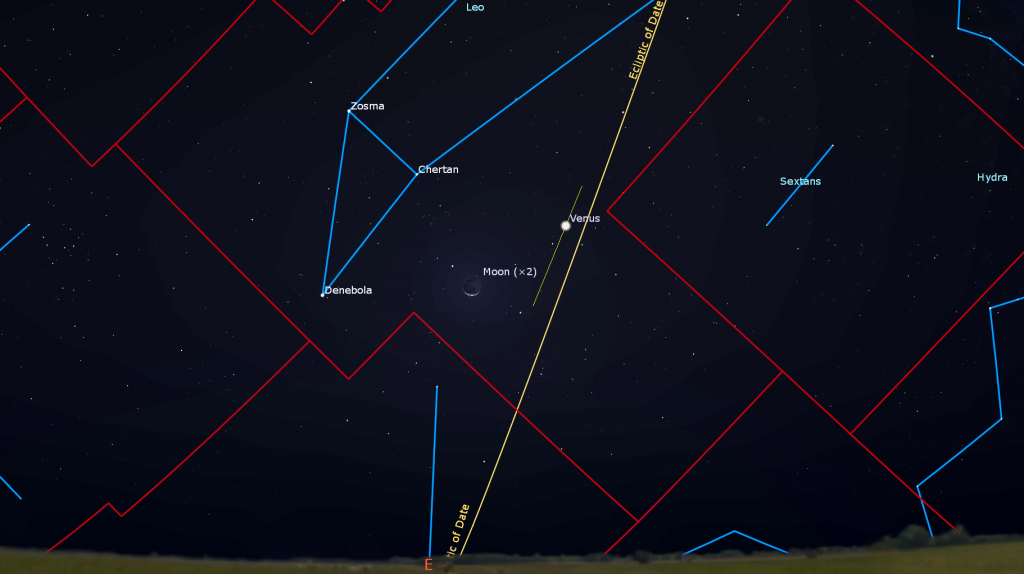
Venus has been gleaming in the eastern pre-dawn sky for some time now. It will rise after 4 am local time this week, and then remain visible in the eastern sky until sunrise while it is carried higher by the rotation of the Earth. Viewed in a backyard telescope, Venus will show a gibbous, more-than-half-illuminated shape. This week, the planet will be passing under the stars forming Leo (the Lion). Venus is shifting towards the sun – but the later sunrises at this time of year will allow it to shine in a dark, pre-dawn sky until early December! And while you’re taking in the show, enjoy a view of the extremely bright star Sirius, and the winter constellation of Orion (the Hunter) sitting well off to Venus’ upper right.
Pegasus Flies across the Sky
The fall and winter evening skies feature a group of easy-to-see constellation that are the characters in a grand story from Greek mythology – the tale of Princess Andromeda and the hero Perseus. I’ll relate that tale in a future post. This week, we’ll look at Pegasus – the westernmost constellation in the myth. But let’s flesh out his story a little first…
Before hunting the Gorgon Medusa, Perseus was given some magical gifts to aid him in his quest, including winged silver sandals called the Shoes of Swiftness. Immediately after slaying the snake-haired Medusa by cutting off her head, he flew into the air to avoid Medusa’s angry sisters. While hovering there, some of the gorgon’s blood dripped onto the seashore below. Poseidon, god of the Sea, mixed the blood with some sea foam, and the magical flying horse Pegasus, whose name is derived from the Greek word for wellspring “pegai”, sprang from the sea.
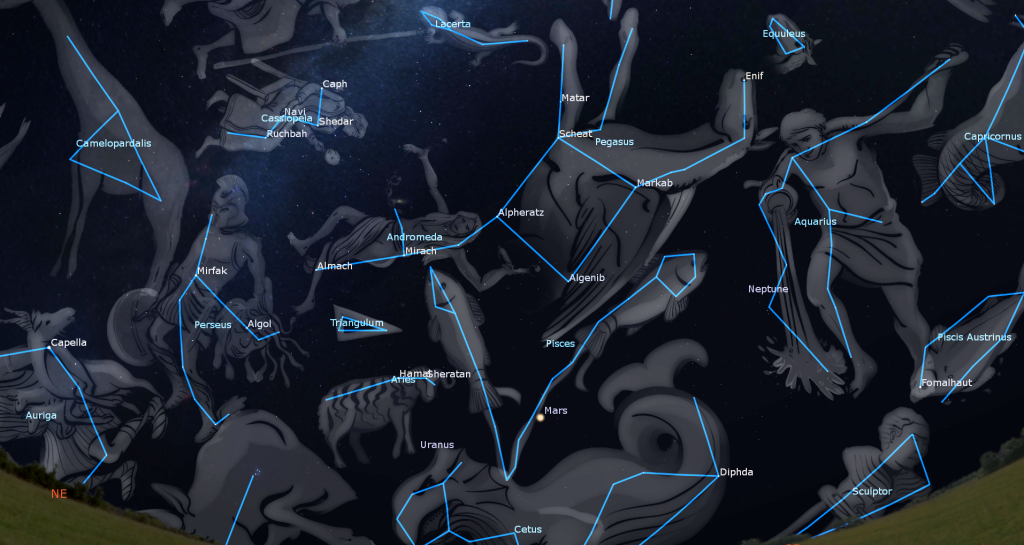
Pegasus has traditionally been associated with beauty, wisdom, and poetry. In some stories, the majestic, wild, white stallion was tamed by the warrior Bellerophon, the most successful hero of ancient Greece – until Hercules came along later. After many heroic deeds astride Pegasus, Bellerophon felt that the he was worthy of living in Olympus with the gods, and attempted to ride Pegasus there. But they denied him – sending a bee to sting Pegasus, who bucked and tossed Bellerophon from his saddle. The hero died from the fall to Earth, but he has an interesting role among the stars – as we’ll cover below. Zeus then added Pegasus to his stables, using him to transport thunderbolts. As a reward for his service, at the end of the horse’s days, he was granted a place among the stars.
The constellation Pegasus (the Winged Horse) enters the eastern evening sky in September, becomes well placed for evening astronomy, high in the southern sky from October to December, and then gradually sinks into the western twilight by February. It is one of the largest (seventh by area) and oldest of the 88 modern constellations. The stars of Pegasus only depict the horse’s head, forelegs, and wings – rising out of the ocean – while the rest of the animal is occupied by the constellation of Pisces (the Fishes). In Chinese astronomy, the stars of Pegasus make up the Black Tortoise of the North, one of the legendary Four Benevolent Animals in the stars.
Pegasus contains one of the most obvious asterisms in the sky. (An asterism is a shape or pattern made up of prominent stars, and it can use some of the stars in a single constellation, or combine stars from adjacent constellations. The Big Dipper is an example of the former case, since the dipper uses only part of the large constellation Ursa Major.) Pegasus’ asterism is a giant square of four equally bright stars called the Great Square of Pegasus – or perhaps a Holiday Season gift box? The shape will probably remind you of a baseball diamond when you see it, because it’s usually tilted with one corner downwards. For the Lakota people, the square represented the great shell of Keya, the Turtle.
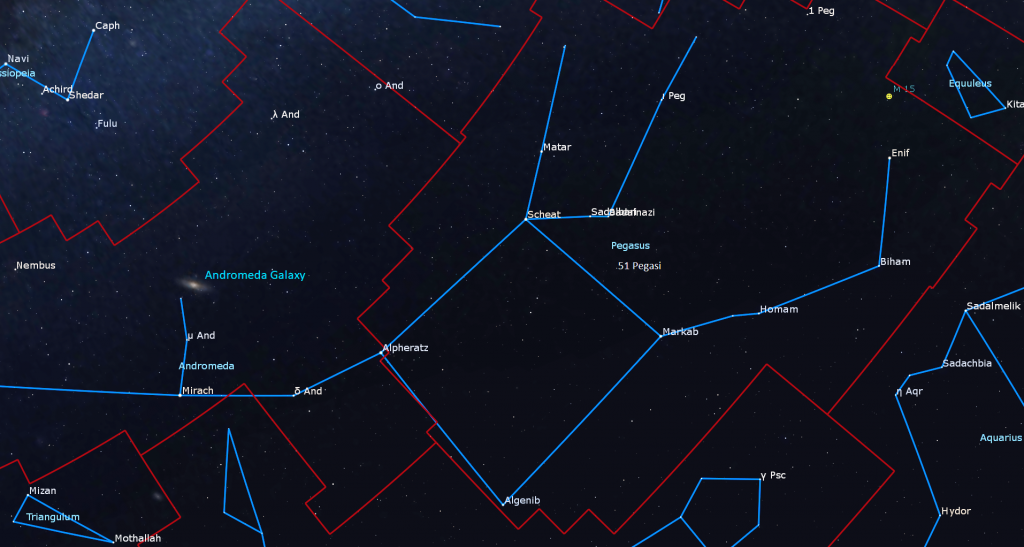
Pegasus has traditionally been depicted upside-down, with the square representing his wings, the stars to the west (on the right) forming the head and neck, and two chains of stars at the upper right of the square representing the front legs. To the west (or right) of Pegasus’ head is a tiny and dim constellation composed of four stars called Equuleus (the Little Horse). Beyond Pegasus’ legs sits the prominent constellation of Cygnus (the Swan), with its bright Summer Triangle star Deneb. Adjoining Pegasus on the eastern (left-hand) side, and sharing a major star with him, is Andromeda (the Princess). The water constellations of Pisces (the Fishes) and Aquarius (the Water-Bearer) are below Pegasus.
Let’s tour Pegasus. After it gets dark, face the southeastern sky. Using unaided eyes only, the Great Square appears empty. You might be able to pick out one or two dim stars inside it – more if you are away from light-polluted skies. The square’s edges are about 16° long (or 1.6 fist widths when held at arm’s length), and about 20° from corner to corner. In mid-October at 9 pm local time, the square’s centre is fairly high in the sky – about two-thirds of the way from horizon to zenith. It’s highest in the southern sky at 10:30 pm. It will set in the west by dawn.
The star at the southeast corner (bottom) of the diamond is Algenib, Arabic for “the Side”. It’s a very hot blue-white star of moderate brightness that sits about 350 light-years away from us, and actually emits 4,000 times more light than our sun! Moving counter-clockwise, the white star at the right-hand corner is Markab “the Saddle”. This star appears slightly brighter than Algenib – it emits less light, but it is only 140 light-years away.

From Markab, look west for the dimmer stars that trace the horse’s neck and head. A palm’s width from Markab is blue Homam “Man of High Spirit”, then another fist’s width further on sits Biham. Both are about equal in brightness. From Biham look a palm’s width higher to the right for bright star Enif “the Nose”. Enif is a cool, orange supergiant star located 670 light-years away from us. It is nearing the last stages of its life cycle. You should be able to perceive that its colour is tinted. Enif is huge! Were it to replace our Sun, it would span 40° of Earth’s sky, eighty times wider than the Sun or Moon! Enif is just at the lower mass limit for dying in a supernova explosion. Use binoculars to scan the sky about four fingers widths to the west of Enif. You’ll find a small, dim, but pretty, fuzzy patch of stars designated Messier 15. That globular star cluster is 33,000 light-years away from us.
Returning to the square, the fairly bright, magnitude 2.4 star at the northwest (top) corner is Scheat “the Foreleg”, the second brightest star in the constellation. It’s a cool, red giant star located 200 light-years away from us. Pegasus’ two front legs start at Scheat and extend upwards to the right. Five degrees to the right of Scheat is the dim yellow star Matar “Lucky Star of Rain”, and the leg terminates a palm’s width farther in the same direction at a double star designated Pi Pegasi or π Peg. Using binoculars you should be able to see that Pi consists of two close-together yellow-white stars.
The second foreleg takes a jog to the lower right before bending back up parallel to the first one. A well-spaced pair of yellowish stars named Sadalbari “Luck Star of the Splendid One” and Lambda Pegasi or λ Peg marks the knee. The foreleg extends to a faint white star a fist’s width to the upper right, and ends at a dim white star an additional 5° away.
There’s a dim yellow star sitting a thumb’s width just outside of the baseball diamond, midway between the top and right corners. This is the sunlike star designated 51 Pegasi. It hosts the first exoplanet ever discovered, in 1995! Dubbed Bellerophon, it is a Jupiter-sized planet that orbits 51 Pegasi every 4.23 days at a distance much closer than Mercury does in our solar system. Planets like this are called hot Jupiters. Take a look at the star in your binoculars and let your imagination soar, like Bellerophon!
The final star of the square, at the northeastern (left-hand) corner, is called Alpheratz “The Horse’s Shoulder”. It’s another hot, blue-white supergiant star, but located only 97 light-years away from us. The spectrum of this star’s light indicates that it is highly enriched in the metal Mercury. In actuality, Alpheratz does not belong to Pegasus. It’s the brightest star in Andromeda, and marks the princess’ head – but that’s a tour for another day!
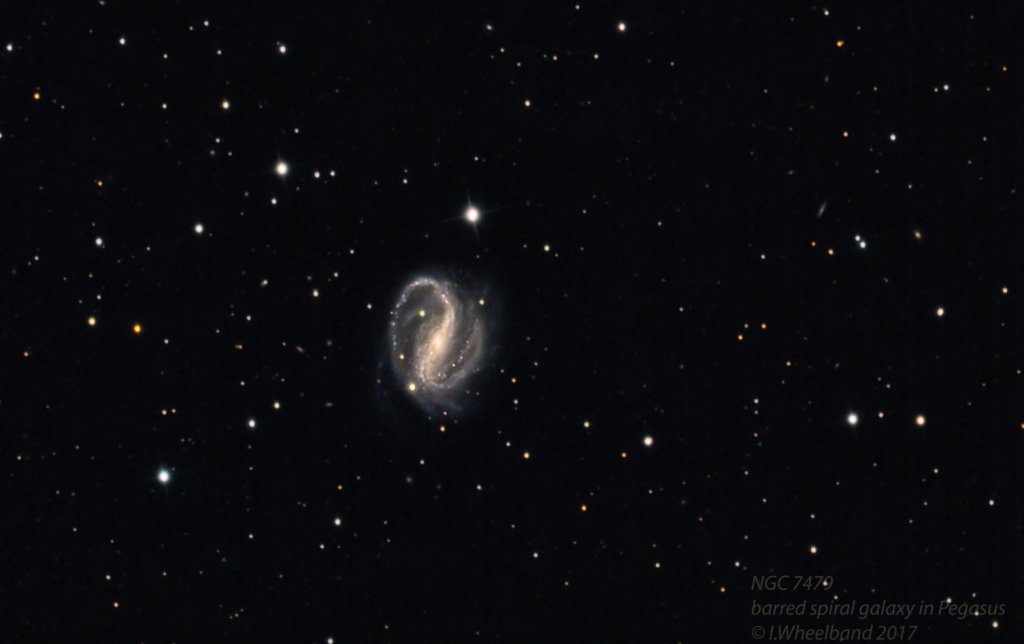
For Skylights readers with good-sized telescopes, Pegasus is loaded with galaxies! This is because the constellation sits well away from the obscuring gas and dust of our Milky Way, allowing us to peer deeper into the Universe. One of my favorite sights is NGC 7479, also designated Caldwell 44, an S-shaped spiral galaxy that resembles Superman’s sigil. In fact –the galaxy’s nickname is the Superman Galaxy! I’ll post a picture of it here.
A few finger widths above (or 3 degrees to the celestial north of) the midway point along the line joining Matar to Eta Peg, you’ll find a particularly busy assortment of galaxies! The Deer Lick Group is composed of the large, magnitude 9.48 spiral galaxy named NGC 7331, plus a number of minor satellite galaxies. Just half a degree below (south) of the Deer Lick you’ll find the tight little Stephan’s Quintet – a gravitationally bound set of five galaxies. Both sets will all appear together in the field of view of a large aperture telescope at low magnification.
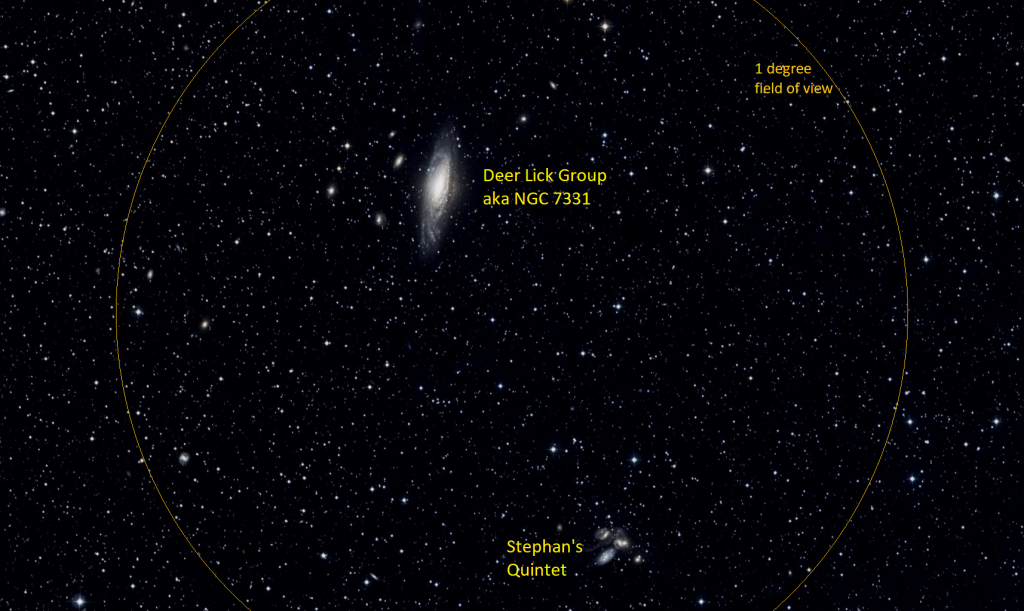
Before you call it a night, take a moment to seek out the Andromeda Galaxy. It is climbing the northeastern evening sky. An all-night target, this large spiral galaxy, also designated Messier 31, is only 2.5 million light years away from us, and subtends an area of sky measuring 3 by 1 degrees – that’s six full moon diameters by two! Under dark skies, the galaxy can be seen with unaided eyes as a faint smudge located 1.4 fist diameters left (or 14 degrees to the northeast) of the square of Pegasus. The three westernmost stars of Cassiopeia (the Queen) – namely Caph, Shedar, and Navi, also conveniently form a triangle that points downwards towards Messier 31. Binoculars will reveal the galaxy better. In a telescope, use low magnification and look for M31’s two smaller companion galaxies, the foreground Messier 32 and more distant Messier 110.
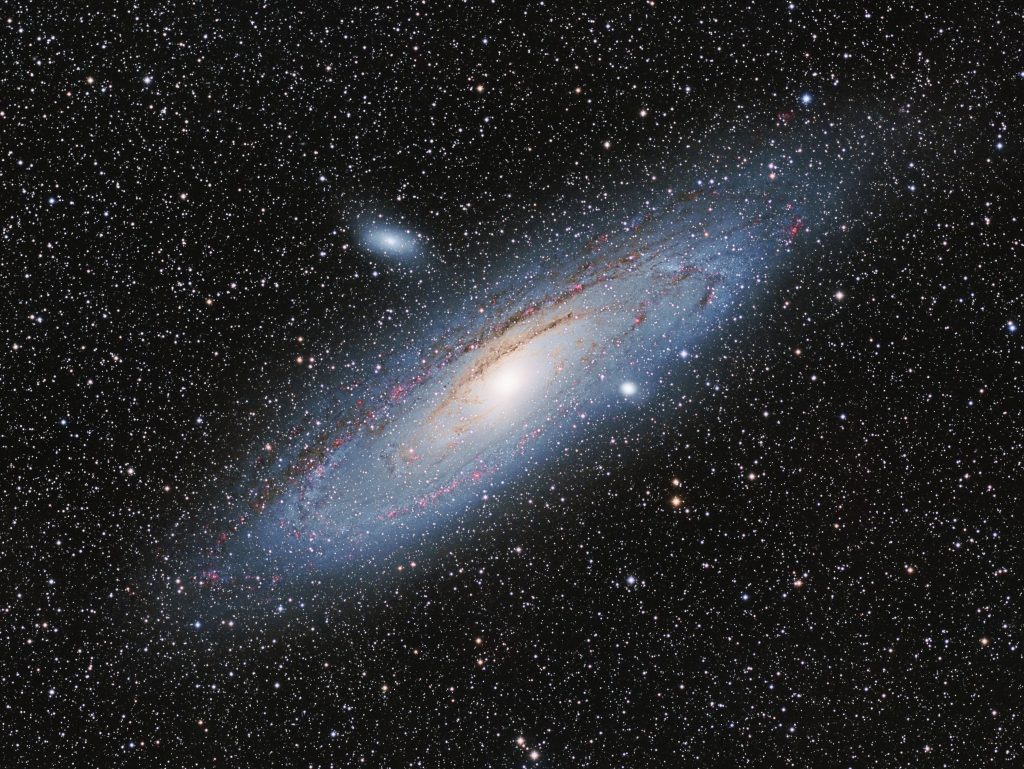
Public Astro-Themed Events
Mars-themed events will continue for a few more days – but not everything will be Martian. Here are some highlights!
Our events at David Dunlap Observatory may be suspended at the moment, but we’re still pleased to offer virtual experiences! On Sunday, October 11 and Monday, October 12 from 9 to 11:30 pm EDT, join us for Virtual Mars Madness. We’ll have special guests, live views of Mars through the historic 74” DDO telescope and from other astronomers across Canada, and some Ask the Astronomer time. This is a rain or shine event. Tickets and more information can be found here.
On clear evenings from Sunday evening, October 11 to Thursday, October 15 between 8 to 10 pm EDT, York University’s Allan I. Carswell Observatory will run a free online viewing party called Journey to Mars. If the weather is clear, head to YouTube for live images and Mars info from their students and volunteers. Details are here, and their stream will be here.
The gang is back to bring you views of Mars! On Tuesday night starting at 8 pm EDT, I’ll be joining Jenna Hinds of RASC National, Ryan Marciniak, John Read, and a special Mars expert for a live streamed event celebrating Mars at Opposition. We’ll discuss observing Mars and bring you live views of the Red Planet from across the country – and answer viewer questions! Register for this free event here.
On Wednesday evening, October 14 at 7:30 pm EDT, the RASC Toronto Centre will live stream their monthly Recreational Astronomy Night Meeting at https://www.youtube.com/rasctoronto/live. Talks include the Sky This Month, and talks about astro-imaging during a pandemic and SkyShed Pods. Details are here.
My free, family-friendly Insider’s Guide to the Galaxy webcasts with Jenna Hinds of RASC National will return on Tuesday, October 20, when we’ll look at out of this world records – the biggest, smallest, brightest, and farthest constellations, stars, and planets – and more! You can find more details, and the schedule of future sessions, here and here. Don’t forget that Jenna and John Reid also stream on alternate Thursdays at 3:30 pm EDT as they progress through the RASC’s Explore the Universe certificate program.
The Canadian organization Discover the Universe is offering astronomy broadcasts via their website here, and their YouTube channel here.
On many evenings, the University of Toronto’s Dunlap Institute is delivering live broadcasts. The streams can be watched live, or later on their YouTube channel here.
The Perimeter Institute in Waterloo, Ontario has a library of videos from their past public lectures. Their Lectures on Demand page is here.
Space Station Flyovers
There are no good ISS (or International Space Station) flyovers for the GTA this week. Pre-dawn passes commence on October 21.
Keep looking up, and enjoy the sky when you do. I love questions and requests. Send me some!